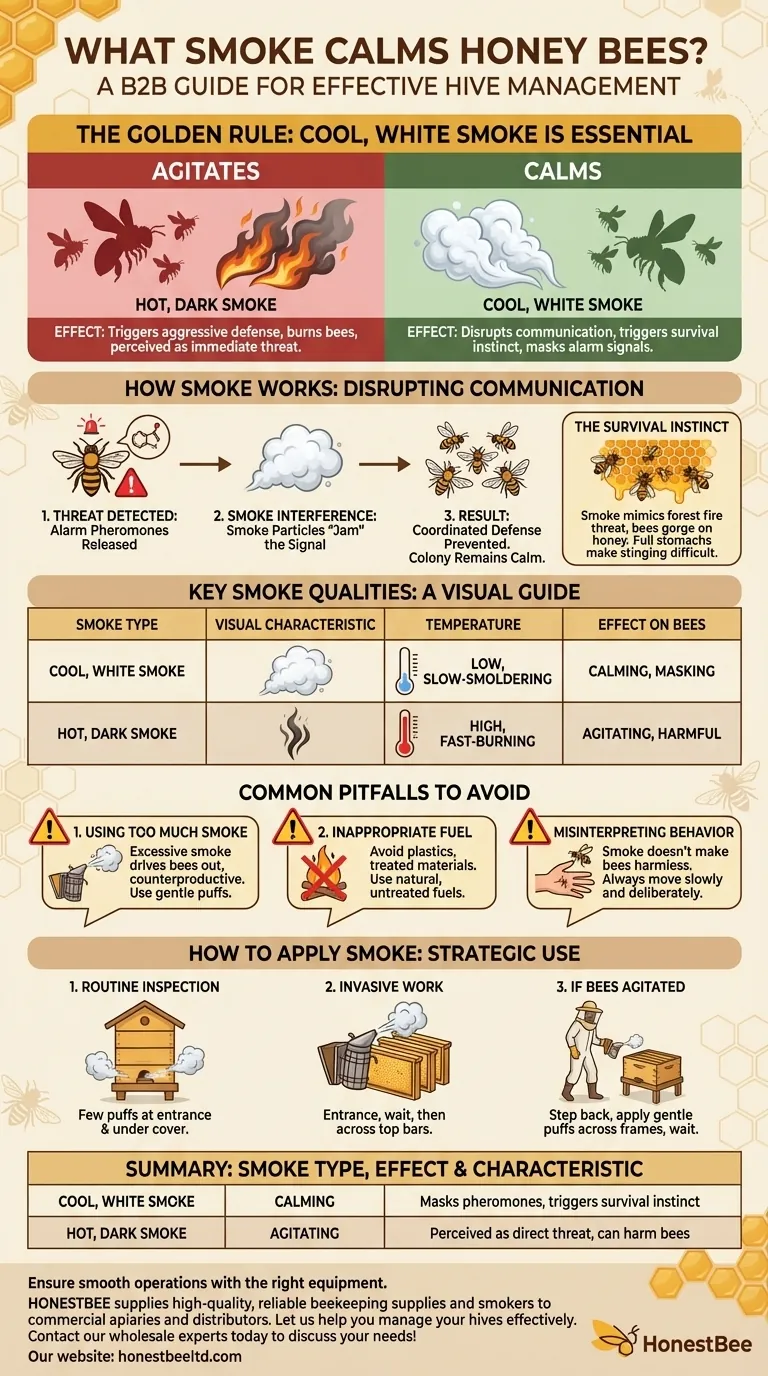To effectively calm honey bees, you must use cool, white smoke. This specific type of smoke is crucial because it works by disrupting the bees' primary method of communication, preventing them from mounting a coordinated defensive response. Hot or dark smoke will have the opposite effect, agitating the bees and making a hive inspection more dangerous.
The purpose of smoke is not to sedate or harm the bees, but to temporarily mask their alarm signals. Understanding this principle is the key to using a smoker correctly and safely managing your hives.

How Smoke Works on a Bee Colony
To use smoke effectively, you must understand what it’s actually doing. It is a communication tool, not a blunt instrument.
The Role of Alarm Pheromones
When guard bees perceive a threat, they release alarm pheromones. These chemical signals instantly alert the rest of the colony to the danger, triggering a unified, aggressive defense.
This pheromone is what tells other bees where to sting and mobilizes a rapid response.
Smoke as a Communication Jammer
The particles in cool, white smoke effectively "jam" this communication system. The smoke masks the scent of the alarm pheromones, preventing the signal from spreading throughout the colony.
Without this signal, the bees cannot coordinate a large-scale defensive action, which slows their response and keeps them in a calmer state.
Triggering a Natural Instinct
Smoke also triggers a secondary, instinctual response. The bees may perceive the smoke as a sign of a nearby forest fire, and their priority shifts from defense to survival.
In preparation to potentially abandon the hive, they will begin to gorge on honey. A bee with a full stomach is physically less able to bend its abdomen to sting and is generally more docile.
Understanding the Key Qualities of Good Smoke
The type of smoke is just as important as the smoke itself. Using the wrong kind can escalate the situation quickly.
What "Cool, White Smoke" Means
Cool, white smoke is the product of a slow-smoldering, low-temperature fire. It indicates incomplete combustion of your fuel source.
This is the ideal smoke because it is dense with particles that mask pheromones but is not hot enough to harm the bees or their delicate wings.
The Danger of Hot, Dark Smoke
Hot, dark, or black smoke is a sign of a fire that is burning too quickly and at too high a temperature. This is often caused by overly dry fuel or too much air.
This type of smoke can burn the bees and is perceived as a direct, immediate threat rather than a distant one, causing agitation and aggression instead of calmness.
Common Pitfalls to Avoid
Using a smoker is a skill, and common mistakes can undermine your efforts.
Using Too Much Smoke
Over-smoking a hive is a frequent error. A few gentle puffs are usually sufficient. Blasting the hive with excessive smoke can agitate the bees, drive them from the frames, and be counterproductive.
Using Inappropriate Fuel
Never use materials that produce toxic or acrid smoke. Avoid plastics, treated lumber, or anything with chemicals. Stick to natural, untreated materials like pine needles, untreated burlap, wood shavings, or commercial smoker fuel.
Misinterpreting the Bees' Behavior
Remember that smoke does not make bees harmless. It only reduces their ability to coordinate. A calm-seeming hive can still have individual bees that will sting if provoked. Always move slowly and deliberately.
How to Apply This to Your Hive Inspections
Your goal dictates how you should apply smoke.
- For a routine, quick inspection: A few gentle puffs at the hive entrance and under the outer cover are often all you need to begin.
- For more invasive work (like a full inspection or honey harvest): Apply smoke at the entrance, wait a minute, then gently puff smoke across the top of the frames as you remove the inner cover.
- If the bees become audibly agitated: Step back for a moment. Apply one or two more gentle puffs of smoke across the frames and give them a minute to calm down before proceeding.
Ultimately, using a smoker is about managing bee communication, not overpowering the colony.
Summary Table:
| Smoke Type | Effect on Bees | Key Characteristic |
|---|---|---|
| Cool, White Smoke | Calming | Masks alarm pheromones, triggers survival instinct |
| Hot, Dark Smoke | Agitating | Perceived as a direct threat, can harm bees |
Ensure your beekeeping operations run smoothly and safely with the right equipment. HONESTBEE supplies high-quality, reliable beekeeping supplies and smokers to commercial apiaries and distributors. Let us help you manage your hives effectively. Contact our wholesale experts today to discuss your needs!
Visual Guide

Related Products
- Premium Traditional Copper Bee Smoker with Bellows
- Economy Galvanized Beekeeping Honey Bee Smoker for Wholesale
- Stainless Steel Honey Bee Smoker Hive and Honeycomb Smoker for Beekeeping
- Professional Bee Smoker with Elongated Spout and Durable Bellows for Beekeeping
- European Stainless Steel Bee Smoker for Honey Bee Hive
People Also Ask
- What are the main parts of a bee smoker? Essential Components for Calm Hive Management
- What is the primary purpose of using smoke in beekeeping? Calm Bees for Safer Hive Management
- What are some alternatives to using smoke in beekeeping? A Guide to Gentle Hive Management
- How does water mist work as an alternative to smoke in beehives? A Guide to Safe & Effective Use
- What is a Smoker and how is it used in beekeeping? The Essential Tool for Calm, Safe Hive Inspections



















